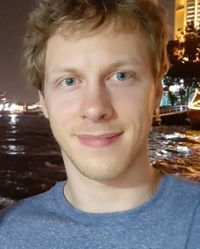James France
PhD candidate / guest
- Name
- Dr. J.M. France
- Telephone
- 071 5272727
- j.m.france@biology.leidenuniv.nl

In my PhD I hope to solve the mystery of evolution of the balanced lethal system in Triturus newts. This genetic anomaly results in the death of half of all individuals in the genus. Understanding how such a disadvantageous trait evolved may yield fascinating insights into the mechanisms of evolution.
More information about James France
Supervisor(s)
Research
Evolution is often introduced as a simple progression of improvements that gradually results in organisms ever more suited for life in their environment. However, evolution is actually the result of a complex process where genes battle to reproduce themselves, against a backdrop of shifting alliances and environmental change. This sometimes yields counterintuitive results, with evolution favouring traits which seem useless or even actively disadvantageous. I am particularly interested in what such “mistakes” can tell us about the process of evolution.
Newts of the genus Triturus (the crested and marbled newts) are victims of one of the most devastating examples of these evolutionary maladaptations. In these newts half of all embryos die before hatching. This is due to a genetic anomaly known as chromosome 1 syndrome.
In Triturus, chromosome 1 occurs in two forms, termed 1A and 1B. In order for an embryo to survive both 1A and 1B must be present. As a result, all adults possess one copy of each form. However, during mating each parent only passes on one of these chromosomes to its offspring – this means that a quarter of all offspring receive two copies of chromosome 1A and another quarter get two copies of 1B. These account for the half of embryos that fail to develop.
The persistence of this balanced lethal system seems to violate the principal of natural selection. However, an explanation may lie in the fact that chromosome 1 does not undergo genetic recombination. This means that genes do not shuffle between chromosomes 1A and 1B, preventing evolution from escaping chromosome 1 syndrome by forming a single hybrid chromosome combining all the essential elements from both versions.
The lack of recombination may also explain how chromosome 1 syndrome evolved in the first place. Non-recombining chromosomes are common in nature and have dramatic effects on the evolution of species. When genes are locked together over long stretches of evolutionary time, they create complexes known as supergenes. Supergenes are inherited and selected for much like normal genes, but can have much more complex effects on the organisms that carry them - a familiar example of a supergene is the male Y-chromosome.
In Triturus newts, the balanced lethal system is made up of two supergenes. Understanding how these supergenes arose is the key to deciphering the mystery of the evolution of chromosome 1 syndrome. Unfortunately, Triturus has a very large genome, ten times larger than humans, which has posed a significant barrier to its study.
I aim to use new advances in targeted sequencing to map the genome of Triturus and its most closely related relatives (the smooth newts of the genus Lissotriton). I hope to identify where the chromosome 1 genes originated from and what functions the supergenes may have originally performed. I am also interested in understanding the evolution of the sex determination syndrome in Triturus and other genera within the family Salamandridae, since it has been suggested that chromosome 1 syndrome may have been created by the exchange of sex-chromosome supergenes.
Brief biography
I completed my bachelor’s and master’s degrees in chemistry and biology at Durham University in the UK. Prior to starting my PhD, I worked as a research assistant at the University of Central Lancashire, also in the UK, where my research focused on the aetiology of Alzheimer’s disease.
PhD candidate / guest
- Science
- Instituut Biologie Leiden
- IBL Animal Sciences

